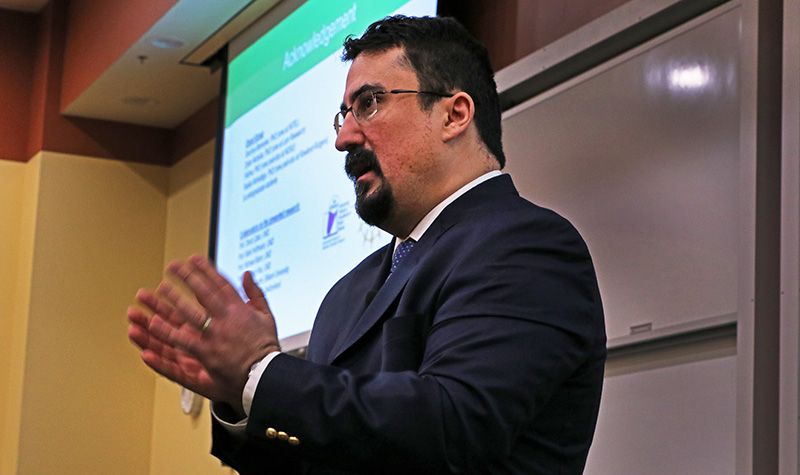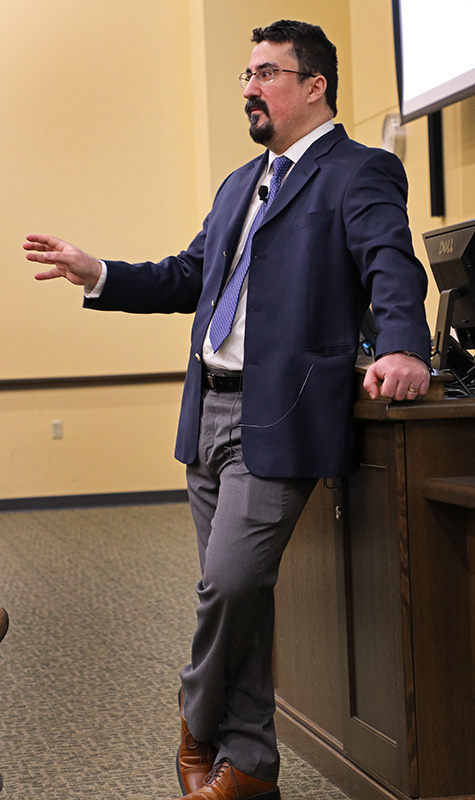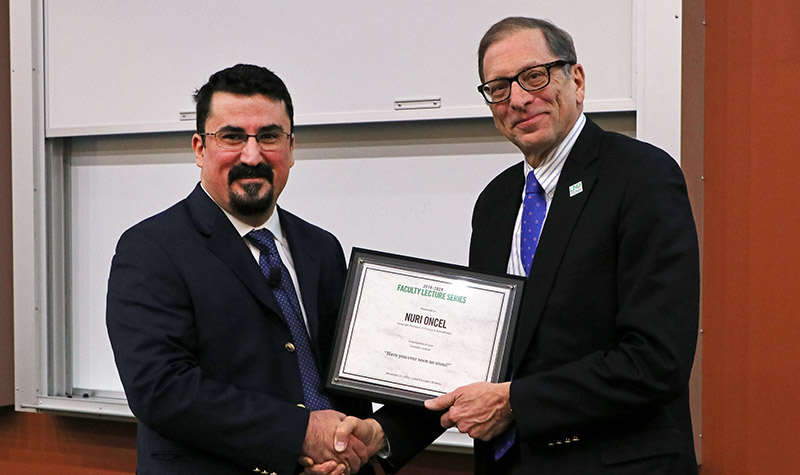07 Dec UND professor pulls back the curtain on tiny world of atoms
‘Impossible,’ physicists once said, when asked whether people ever could see atoms. Today, physicist Nuri Oncel would answer, ‘Very possible indeed’

Nuri Oncel, associate professor of physics and astrophysics, gave a presentation titled “Have you ever seen an atom?” for the Nov. 20 Faculty Lecture Series. Photo by Patrick C. Miller/UND Today.
Can you see an atom?
In his recent Faculty Lecture on that topic at the University of North Dakota, Nuri Oncel, associate professor in the Department of Physics and Astrophysics, answered that question this way:
No.
Yes.
And yes.
No, you can’t see an atom the way we’re used to “seeing” things – that is, using our eyes’ ability to perceive light. An atom is simply too small to deflect visible light waves, which means it won’t show up under even the most powerful light-focusing microscopes, Oncel said.
But …
Yes, you can see an atom, once you understand that we can examine surfaces with beams of electrons rather than light. Scanning tunneling microscopes generate electron waves that can interact with atoms. The microscopes measure that interaction and turn those readings into images of the atoms, often in astonishing detail, Oncel said.
And …
Yes, you can “see” atoms with a long-range view as well. In Oncel’s case, this has led him to study – at the atomic level – technologically important crystal surfaces.
![]()
Silicon is a crystal, and by cutting a cube of silicon at various angles, scientists can generate planes or planar surfaces that feature various patterns of atoms. Si(111) refers to one such plane. On the left of this slide from Prof. Oncel’s PowerPoint presentation is a schematic of the atomic structure of the surface of Si(111). On the right is a scanning tunneling microscope image of that surface, colorized to more clearly show the atomic structure. Image courtesy of Nuri Oncel/University of North Dakota.
For the long-range view shows how seeing – and studying, experimenting with and manipulating – atoms in this way not only contributes to the sum of human knowledge, but also helps advance the extraordinary technologies that have revolutionized life on Earth.
Those technologies include the desktop, laptop or smartphone on which you’re reading this story.
“Nature uses atoms to form molecules and structures,” Oncel said.
“And the things that we are interested in, we want to make them by ourselves. We want to actually control atoms and put them in the correct places in order to make useful structures. That’s our motivation for the whole thing.”
Seeing atoms via electron microscopy is making possible ever smaller and faster computers, as well as astonishing new materials such as graphene. Isolated as recently as 2002, graphene is the first two-dimensional material ever discovered. It’s a latticework of carbon atoms that’s only a single atom thick and yet, in proportion to its thickness, is 100 times stronger than steel.
“I am an experimental physicist, and my goal is to find new materials that have novel physical and chemical properties,” Oncel said.
Seeing atoms is helping Oncel and his colleagues do just that.
Quantum mechanic

Nuri Oncel. Photo by Patrick C. Miller/UND Today.
The Faculty Lecture Series is a chance for UND faculty to describe their research to their colleagues in other departments, as well as to the public. That’s a wonderful but real challenge – especially in a field such as physics, which involves advanced math and other hard-to-explain concepts, said Kanishka Marasinghe, professor and chair of the UND Department of Physics and Astrophysics.
“And that’s even more true in this case, because we are talking about things that are one-hundred-thousandth the width of a hair,” Marasinghe told UND Today, just before he introduced Oncel to the audience.
“We never see that with our eyes and can’t even imagine how small it is. So, trying to tell people that we’re dealing with things at this scale and then explaining that, even for a well-informed audience – yes, it’s a challenge.”
Oncel met the challenge by describing not only the utility but also the beauty and wonder of objects on the atomic scale.
For example, while the movements of planets and other large objects can be explained by classical physics, explaining nature at its smallest demands a whole new theory: quantum physics.
That’s the theory that underlies scanning tunneling microscopes, one of which is in Oncel’s lab. STMs use quantum tunneling, an effect in which electrons move through a barrier due to their wave-like properties.
Oncel used an animated Road Runner cartoon to illustrate. In the cartoon, Coyote paints a tunnel on the side of a mountain. Then he awaits the Road Runner, who approaches – and zips through the tunnel.
“So, my machine is like the Road Runner,” Oncel said, drawing laughter from the audience.
Research: Formalized curiosity
Physics also can help predict the future, Oncel noted. Consider this quote from Intel co-founder Gordon Moore: “Integrated circuits will lead to such wonders as home computers … automatic controls for automobiles, and personal portable communications equipment.”
Then consider that Moore made that observation in 1965, and you’ll see how useful a close understanding of the atomic and subatomic worlds can be, Oncel suggested.

UND President Joshua Wynne (right) presented Nuri Oncel with a certificate as a presenter for the UND Faculty Lecture Series. Photo by Patrick C. Miller/UND Today.
As for beauty, Oncel described his NanoArt collaboration with Betsy Thaden, art teacher at Red River High School in Grand Forks.
In that outreach effort, Oncel shows students his scanning tunneling microscope images of atomic structures, and the students transform those images into art.
As the students’ striking and colorful artworks attest, there’s more to physics than equations and abstractions, Oncel said in his lecture. And that’s the point: to let students know that physics and other sciences can inspire not only understanding but also joy.
“Like the stained glass windows on the cathedrals of Europe,” Oncel said.
“You’ve got to know a heck of a lot of chemistry to create colored glass. … It starts from science, and experienced artists know and respect the science of it.”
At times during his talk, Oncel described the research he and his collaborators have conducted and explained the papers that were the result. The titles of these papers – “Coulomb blockade and negative differential resistance at room temperature: Self-assembled quantum dots on Si (110) surface” is one – may be hard for the lay reader to understand.
But their purpose should not be, Oncel noted, as they’re all expressions of one of the University’s most fundamental and important purposes: to grow our understanding of the universe through research.
And they all, at their core, are efforts to “see” atoms in ever richer and greater detail. For as another scientist once put it: “Given how small the atom is, it’s amazing how much physics we can get out of it.”


